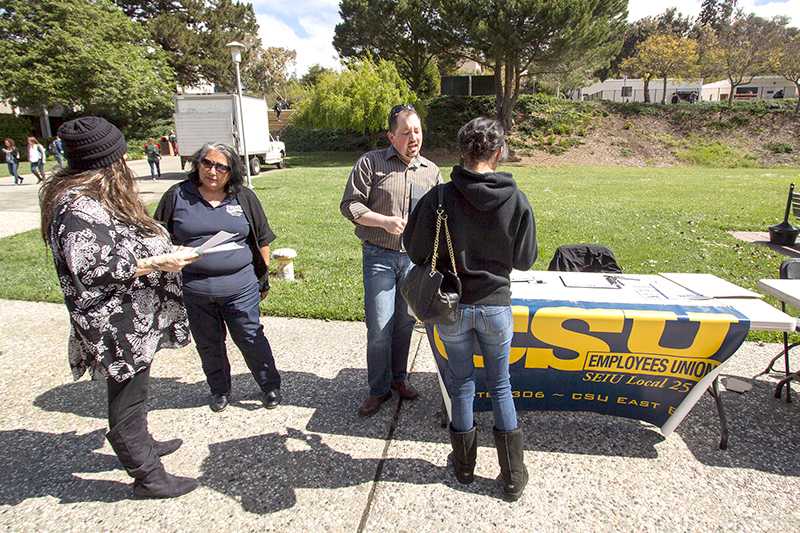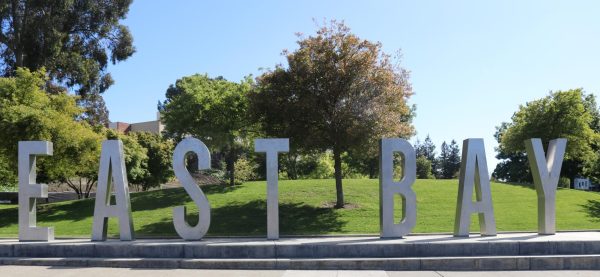Union negotiates against governor’s education budget
California State University Employees Union gathers signatures in an effort to increase funding to the CSU budget.
May 1, 2014
The California State University Employees Union has hosted a series of “Take a Stand!” rallies throughout the CSU system recently in an effort to increase funding to the CSU budget.
Their initiative is in response to Governor Jerry Brown’s proposed allocation of $142.2 million for the CSU system that will go through for the 2014-15 academic year, which fell short of the $237.6 million budget requested by the CSU board in November of last year.
At the CSU Board of Trustees meeting in November, the trustees reviewed a support budget. The support budget, which would increase the General Fund to $237 million, was sent to the department of finance to use in the January budget proposal.
At a rally on California State University, East Bay campus April 3, members of the employees union said they want to freeze tuition at their current 2012-13 levels of $6,549 for a full-time undergraduate resident and $15,477 for a full-time undergraduate non-resident, according to the CSUEB cost and financial aid webpage.
The union is also calling on the CSU Board of Trustees to retain experienced faculty members instead of contracting out workers, “that would turn the work over to someone who can pay less and do more,” said the CSU Chancellor’s Office on June 7, 2012 about contracting out the bargaining unit work. The bargaining team is made of statewide and chapter leaders, staff, and employees in the bargaining unit who are affected, especially custodial workers.
The employees union’s bargaining team also came with their input on the contract. The new contract was released in March 2012 and will be effective through June, with CSU and CSUEU coming to an agreement. “The agreement, covers more than 15,000 CSU employees, including administrative and technical support as well as healthcare and service workers,” as stated in a CSUEU newsletter.
“Today it is very important that we stand up for improving our higher education system. We’re trying to show solidarity, we’re trying to make sure that everyone understands that the students and faculty are all one in this effort,” said the President of CSU East Bay, Chapter 306, Diego Campos.
Several representatives of CSUEU went through campus requesting petition signatures that Campos said will be sent to the Board of Trustees. They gathered more than 200 signatures on the CSUEB campus alone.
“Right now, the fight is with the governor. He basically told us, ‘Here’s 142 million dollars, if you want to compensate or put it towards the students, do whatever you want with it, but that’s all I’m giving you,’” said Campos.
In meetings with the Board of Trustees in the fall, Brown repeatedly told the board members he was unable to allocate any additional funds. In the official 2014-15 budget summary, Brown’s plan is to “[grow] General Fund support for UC and CSU by 5 percent in 2014-15 and by 4 percent in each of the subsequent two years.”
“Any increase [in the CSU budget] is helpful towards accomplishing the CSU mission. When we put together our budget proposal in November, it did include areas where we would like to see additional funding,” said Mike Uhlenkamp, director of public affairs at the Long Beach based CSU Office of the Chancellor. “Employee compensation is an issue, it was one of those areas. Enrollment growth is one of those areas. So these are things that we have determined are important needs for the CSU.”
Increased state support is distributed to campuses based on enrollment of full-time equivalent students. 22,000 or more CSU-eligible California students were denied enrollment for fall 2012, in comparison to the 6,174 that was denied around the same time in 2008.
“It’ll give better access to at least 20,000 more students, take care of some of the enrollment backlog so that students can graduate faster, and also it’ll have positions back that were lost for three or five years,” said Patrick Gantt, president of the employees union.
Student fees are at a historic high, state funding to the CSU remains at 1998-99 levels, according to the employees union’s VP for Organizing Mike Geck. In 1998-99, the CSU was serving 281,782 students and CSU state allocation was $2.25 billion. By 2007-08, the amount of full-time equivalent students that were being served increased by 72,133, increasing the number of students to 353,915 and the amount of money distributed dramatically hiked up to $2.97 billion.
Now at the 2013-14 levels, the CSU is serving approximately 66,218 more students as compared to 1998-99 and currently being funded with $2.33 billion. The decrease is a direct result of the $500 million dollar cut in state funding which was made during the 2011-12 fiscal year. These numbers are the closest it has ever been to the 1998-99 levels, according to the CSU budget office.
“Students wouldn’t be able to get the class that they want to take and without that, they wouldn’t be able to pursue their education, get a degree, and start their career or profession,” said CSUEB student Daniel Vasquez during the rally.
The Board of Trustees’ next milestone is in May. Between January and May the department of finance and the governor will look at the economic situation going on in the state of California. From there, the revisions will be made and finalized by the end of June 2014, said Uhlenkamp.
Petitions from all 23 union chapters that are a part of the CSUEU will be presented at a May 20-21 Board of Trustees meeting in Long Beach where CSU Chancellor Timothy White will make approvals to the bargaining contract and revisions to the budget plan.
















